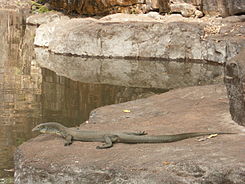- Mertens' Water Monitor
-
Mertens’ Water Monitor 
Conservation status Scientific classification Kingdom: Animalia Phylum: Chordata Class: Sauropsida Order: Squamata Suborder: Lacertilia Family: Varanidae Genus: Varanus Species: V. mertensi Binomial name Varanus mertensi
Glauert, 1951Mertens’ Water Monitor (Varanus mertensi), often misspelled Merten’s Water Monitor, is a member of the monitor lizard family found in northern Australia, and is a wide-ranging, active foraging, opportunistic predator of aquatic and riparian habitats.[1] It is named after German herpetologist Robert Mertens.
Contents
Description
The monitor grows to a length of about one metre. It is dark brown to black above, with many cream to yellow spots. The underparts are paler – white to yellowish – with grey mottling on the throat and blue-grey bars on the chest. The tail is strongly compressed laterally, with a high median dorsal keel, and is about 1.5 times the length of head and body.[2]
Distribution and habitat
 Mertens' Water Monitor at the Grotto waterhole near Wyndham, Western Australia.
Mertens' Water Monitor at the Grotto waterhole near Wyndham, Western Australia.
The monitor is found in coastal and inland waters across much of northern Australia, from the Kimberley region of Western Australia, across the Top End of the Northern Territory and the Gulf Country, to the western side of the Cape York Peninsula in Far North Queensland.[2]
Behaviour
The monitor is semi-aquatic, a strong swimmer and seldom far from water. It is often seen basking on mid-stream rocks and logs, and on branches overhanging swamps, lagoons and waterways throughout its range. When disturbed it drops into the water where it can stay submerged for long periods.[2]
Feeding
The monitor feeds both on land and in the water, mainly on fish, frogs and carrion, also taking terrestrial vertebrates and insects when available.[2] It has a good sense of smell and may dig up prey when foraging, including the eggs of freshwater turtles.[3]
Breeding
The monitor lays eggs in a burrow, usually with egg-laying taking place early in the dry season and hatching in the following wet season. The eggs hatch within 200–300 days after laying, depending on temperature, with the hatchlings able to enter the water and swim immediately.[3][4]
Conservation and status
Mertens’ Water Monitors are threatened by the spread of Cane Toads through their range, through poisoning after eating them. Because of this they are listed as Vulnerable under Northern Territory legislation.[3]
References
- ^ Mayes, Phillip James (2006). The ecology and behaviour of Varanus mertensi (Reptilia: Varanidae) (Dissertation submitted for the Degree of Doctor of Philosophy). Perth, Western Australia: Faculty of Natural Sciences, Edith Cowan University.
- ^ a b c d Cogger, H.G. (1979). Reptiles and Amphibians of Australia. Sydney: Reed. pp. 257. ISBN 0-589-50108-9.
- ^ a b c "Threatened Species of the Northern Territory: Mertens Water Monitor". Simon Ward, John Woinarski, Tony Griffiths and Lindley McKay (compilers). Department of Natural Resources, Environment and the Arts, Northern Territory. November 2006. http://www.nt.gov.au/nreta/wildlife/animals/threatened/pdf/herps/varanus_mertensi_vu.pdf. Retrieved 10 January 2010.
- ^ OzAnimals.com: Mertens’ Water Monitor
External links
Varanoidea Extant species Argus monitor · Black tree monitor · Bengal monitor · Black-spotted Ridge-tailed Monitor · Crocodile monitor · Desert Monitor · Dumeril's monitor · Emerald tree monitor · Gray's monitor · Kalabeck's monitor · Kimberley Rock Monitor · Komodo dragon · Lace monitor · Mangrove monitor · Mertens' Water Monitor · Nile monitor · Peacock monitor · Peach Throat Monitor · Perentie · Rock monitor · Pilbara monitor · Rennell Island Monitor · Rosenberg's Monitor · Short-tailed monitor · Spiny-tailed monitor · Timor tree monitor · Turquoise monitor · Sand goanna · Savannah monitor · Water monitor · Yellow MonitorRelated categoriesMonitor lizards · Cretaceous lizards · Helodermas · MosasaursFossil species DolichosauridaeHelodermatidaeVaranidaeCategories:- Monitor lizards
- Reptiles of Australia
- Reptiles of Western Australia
- Animals described in 1951
Wikimedia Foundation. 2010.
